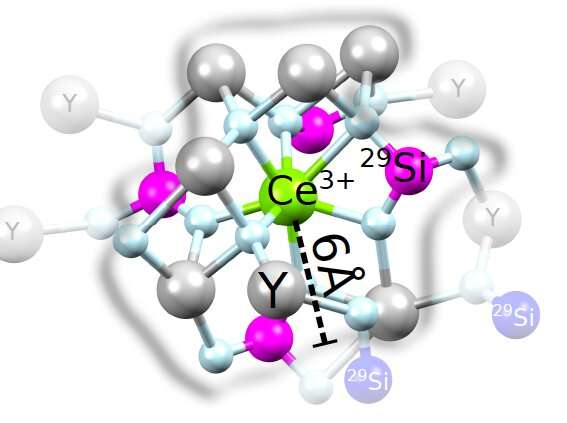May 19, 2020 feature
Detecting individual nuclear spins with single rare-earth ions hosted in crystals

Rare-earth minerals are a class of materials with similar properties that are currently used to build a variety of devices, including LEDs, rechargeable batteries, magnets, lasers, and much more. These materials' electron spins can be hosted in crystals, creating systems with unique characteristics that could serve as interfaces between telecom-band photons and long-lived spin quantum bits.
Interestingly, these systems present electron spins that interact with surrounding nuclear spins, and they could thus be particularly useful for the development of quantum memory tools. So far, however, no researchers were able to sense or detect proximal nuclear spins hosted in rare-earth related crystals.
In a study featured in Physical Review Letters, researchers at the University of Stuttgart and the Beijing Computational Science Research Center succeeded in detecting these proximal nuclear spins, more specifically, those near single Ce3+ ions hosted in a yttrium orthosilicate (YSO) crystal. Their study built on a previous paper published in Nature Communications, in which they explored the coherent properties of single rare-earth ions hosted in a different crystal.
"Our previous study was conducted on a YAG crystal, which has an even denser spin bath than YSO, and showed relatively short coherent interaction time for the investigated electron spins," Roman Kolesov, one of the researchers who carried out the study, told Phys.org. "The measured coherence time gave the motivation to investigate cerium in another host crystal with slightly more dilute nuclear spin bath, namely YSO, which still has a considerable amount of nuclear spin isotopes with 100% yttrium-89 and 5% silicon-29."
In their new study, Kolesov and his colleagues wanted to investigate electron spins with a prolonged coherence time, which is what ultimately led them to examine rare-earth materials in a YSO host crystal. A long enough coherence time, in fact, would ultimately allow them to sense external nuclear spins, which was the primary objective of their work.

"Individual nuclear spins can be detected based on fluorescence signals of investigated rare-earth ions," Thomas Kornher, one of the researchers who carried out the study, told Phys.org. "In our experiments, we excited the cerium electron with circularly polarized laser pulses into a specific spin state. Using a microwave field, the spin was then brought into a superposition state, which can pick up the perturbation of external nuclear spins."
Kolesov, Kornher and their colleagues were able to extract this perturbation of external nuclear spins, as a fluorescent signal given off by another sequence of laser pulses. Most notably, they successfully extracted the signal of an individual external nuclear spin in a dense nuclear spin bath. Their paper thus established single rare-earth ions as valuable probes for detecting single nuclear spins in their environment.
"If you consider addressable single nuclear spins as a potentially useful resource in quantum technologies, such as quantum error correction schemes, then sensing them based on single rare-earth ions provides access to a broad range of materials, that can now be considered for quantum applications," Kornher said. "The broad range of new materials is based on the versatile doping of rare-earth ions into solid state hosts, which is a well-studied field building on investigations into laser physics."
The recent study carried out by this team of researchers gathered new important findings that could open up new possibilities for the development of quantum memory applications utilizing rare-earth ion systems, which are based on coupled environmental nuclear spins. In their future work, Kolesov, Kornher and their colleagues would like to investigate nuclear spin initialization that could enable access to nuclear spins. More specifically, they plan to manipulate the individual nuclear spins detected in their recent study and implement quantum logic gates on them.
"One metaphor to explain the achievements of our study could be that we were able to hear the very quiet tone of a mosquito (let it be even a quantum mosquito) in a street with heavy traffic (spin bath)," Kolesov said. "So far, we can only hear it, but the next task would be to control its flight and the ultimate goal to control several mosquitoes at once distinguishing them by their slightly different voices."
More information: Thomas Kornher et al. Sensing Individual Nuclear Spins with a Single Rare-Earth Electron Spin, Physical Review Letters (2020). DOI: 10.1103/PhysRevLett.124.170402
P. Siyushev et al. Coherent properties of single rare-earth spin qubits, Nature Communications (2014). DOI: 10.1038/ncomms4895
Journal information: Physical Review Letters , Nature Communications
© 2020 Science X Network




















